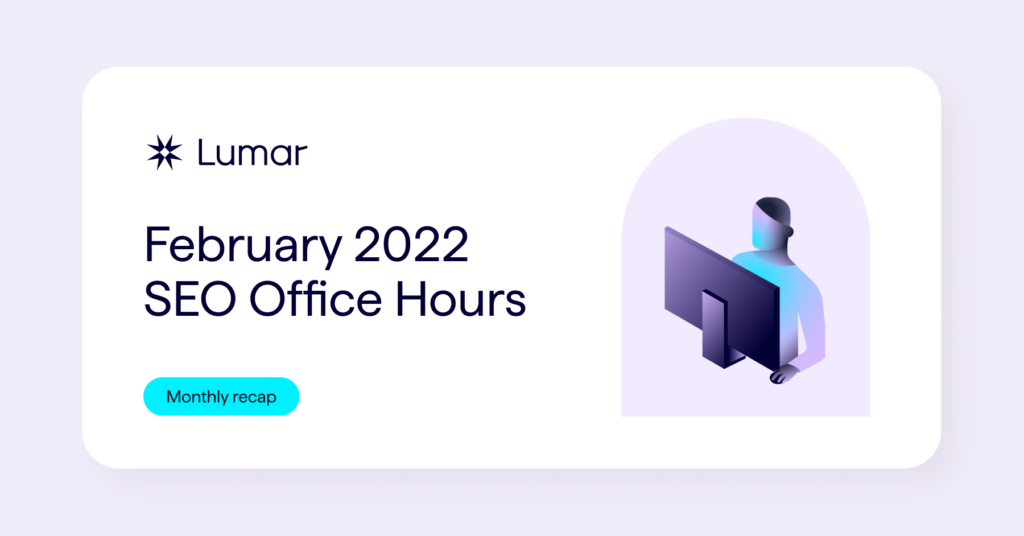Our latest recap of Google Search Central‘s “SEO Office Hours” sessions is here! Stay up-to-date with the latest SEO advice from Google in this ongoing blog series by Deepcrawl.
The notes below are our key takeaways from the February 2022 sessions, but you can also browse our full Office Hours library to get tips relating to the topics that interest you most.
Alt text associated with a linked image is treated the same as anchor text
A question was asked regarding an “a href” tag that contained both anchor text and an image with alt text. Which one helps Google to better understand what the linked page is about? And does the order in which they occur within the tag matter? John replied that the order of these two elements within the ahref tag would not matter. With just an image, it wouldn’t be as valuable as anchor text, but if alt text is associated with the linked image, Google would treat that the same as anchor text. It would be converted into text on the page and treated the same.
He did further clarify that this news shouldn’t mean that all visible text should be removed and alt text relied upon. But it should help to know that you’re not losing anything by including both. Other search engines may not see image alt text and anchor text as equivalent and, for accessibility and usability reasons, it may make sense to have visible text there too.
Skip directly to this part of the session video below:
Check out our full SEO Offices Hours Library for more tips relating to Alt Tags and Anchor Text.
Updating backlinks to a migrated domain helps with canonicalization
An attendee was talking about a website migration from domain A to domain B. They were setting up redirects to the new domain but asked whether the page authority and rankings would be negatively affected if there were many existing backlinks that point to domain A.
John replied that setting up redirects and using the Change of Address tool in Search Console will help Google understand the changes that have occurred during a site migration. However, he said that, on a per-page basis, they also try to look at canonicalization. When dealing with canonicalization on migrated domains, John said that redirects, internal links, and canonical tags play a role —- but external links also play a role. What could happen, if Google sees a lot of external links going to the old URL, is that they might index the old URL instead of the new one. This could be because they think the change might be temporary due to these linking signals. During site migrations, they recommend finding the larger websites linking to your previous domain and requesting that those backlinks are updated to make sure that they can align everything with the new domain.
Get more SEO tips relating to Site Migrations.
If URLs blocked by robots.txt are indexed by Google, it may point to insufficient content on the site’s accessible pages
Why might an eCommerce site’s faceted or filtered URLs that are blocked by robots.txt (and have a canonical in place) still get indexed by Google? Would adding a noindex tag help? John replied that the noindex tag would not help in this situation, as the robots.txt block means it would not be seen by Google.
He pointed out that URLs might get indexed without content in this situation (as Google cannot crawl them with the block in robots.txt), but they would be unlikely to show up for users in the SERPs, so should not cause issues. He went on to mention that, if you do see these blocked URLs being returned for practical queries, then it can be a sign that the rest of your website is hard for Google to understand. It could mean that the visible content on your website is not sufficient for Google to understand that the normal (and accessible) pages are relevant for those queries. So he would first recommend looking into whether or not searchers are actually finding those URLs that are blocked by robots.txt. If not, then it should be fine. Otherwise, you may need to look at other parts of the website to understand why Google might be struggling to understand it.
For more on thin content, robots.txt disallow directives, and indexing issues, check out our Library pages.
Use the URL Removal Tool to quickly hide pages from appearing in Google SERPs
An attendee asked about how to remove thousands of unwanted pages that are still indexed following a malware attack. Due to the number of URLs affected, the attendee thought it wasn’t possible to use Google’s URL Removal Tool to manually remove each one after the attack was resolved.
John responded that the first thing to check is that these pages have actually been removed, as sometimes URLs can show as removed for the user but not for Google. This can be checked using the URL Inspection Tool within Search Console. Then he recommended two further approaches. First: make sure that the more visible pages to searchers are manually removed using the URL Removal Tool. This would involve removing pages shown when searching for your primary products or company name, so that those hacked pages are not visible to searchers. The tool doesn’t take these URLs out of Google’s index, but it does stop them from appearing in the search results. The remaining URLs could take another couple of months to be fully recrawled and removed. This can be fine if they are not likely to be found by searching, and you could check again in half a year. If you need them all removed faster, you could use the prefix setting with the URL removal tool. To do this, you would find common prefixes (such as a folder name, file name, or something in the beginning) and filter those out.
Learn more about SERP features and tools in our SEO Office Hours Library. Or in our article, “State of the SERPs: 7 Enhanced SERP Features & Rich Result Types to Know”.
Using emojis in page titles or meta descriptions will not harm (or help) SEO
Is it okay, from an SEO standpoint, to use emojis in website page titles or meta descriptions? John replied that it is ok to use emojis in your page titles and descriptions, but they may not all be shown in the search results (especially if they think that it disrupts the search results or looks misleading). However, there is no significant advantage to using emojis either. Basically, using emojis doesn’t hurt or harm SEO. At most, Google may try to understand an equivalent word for the emoji, but overall, using emojis is unlikely to either hurt or benefit SEO.
Get more SEO tips on page titles and meta descriptions.





